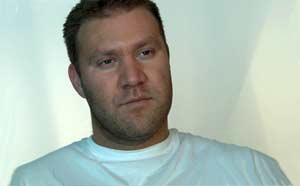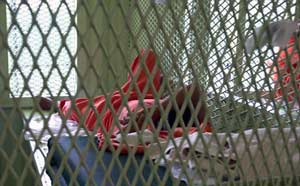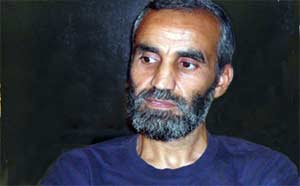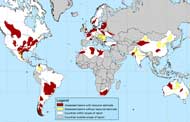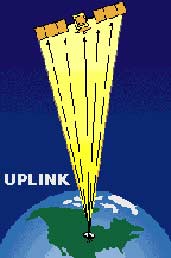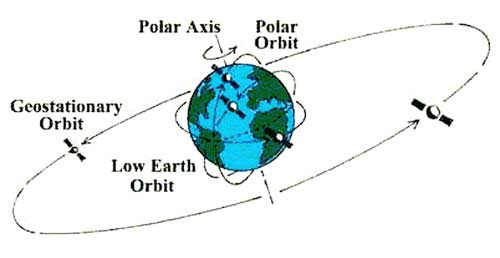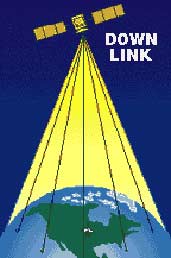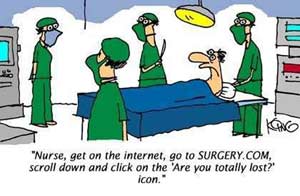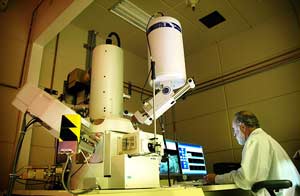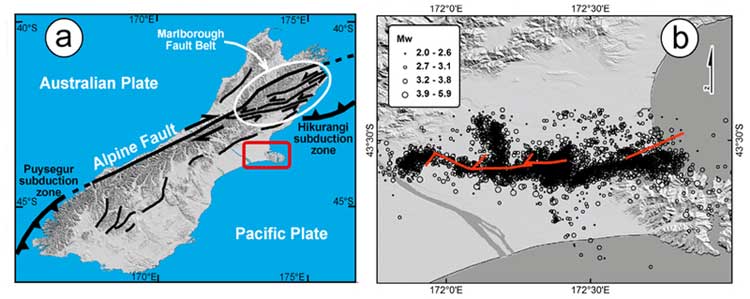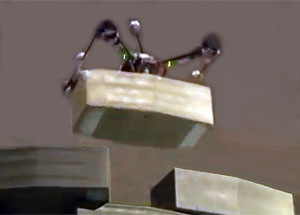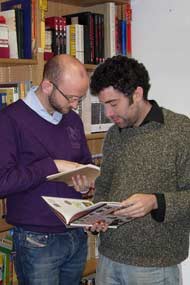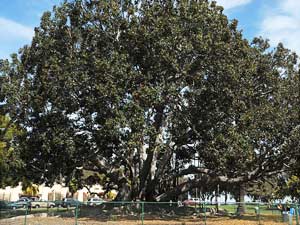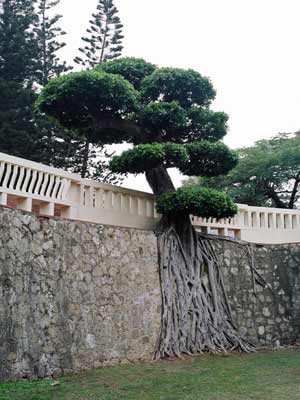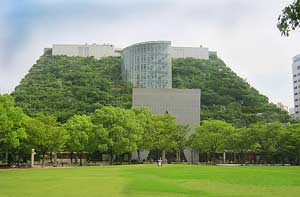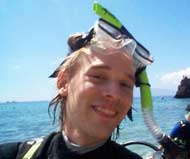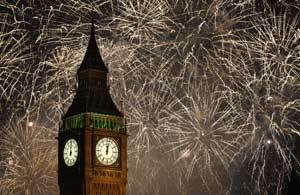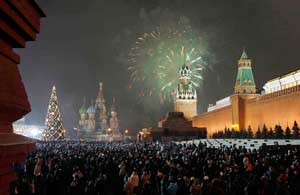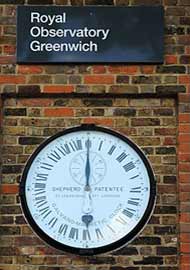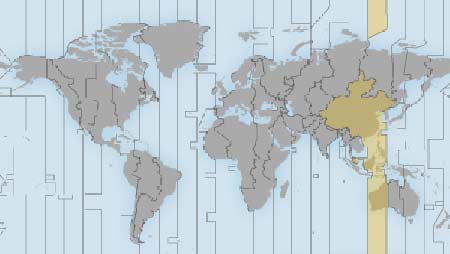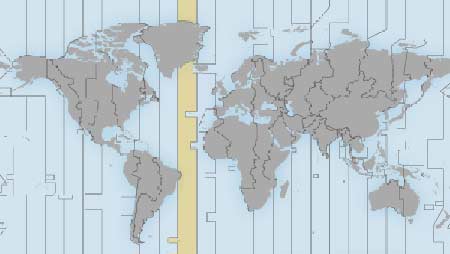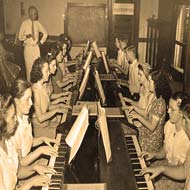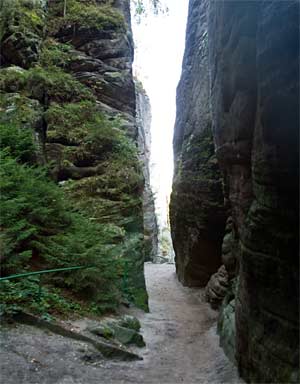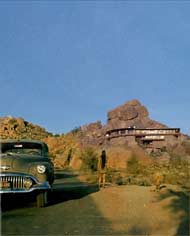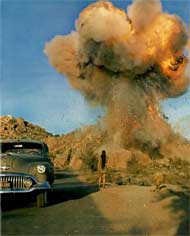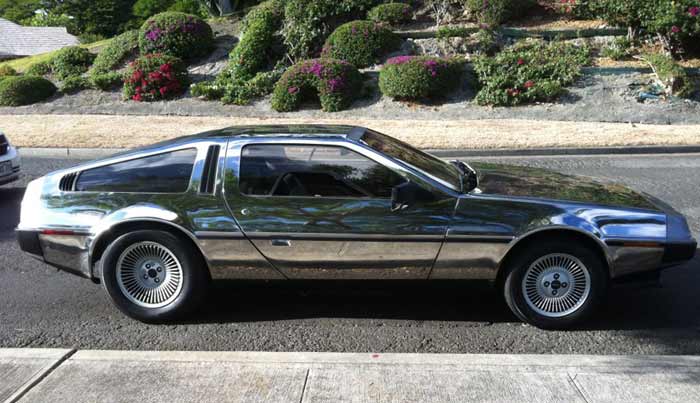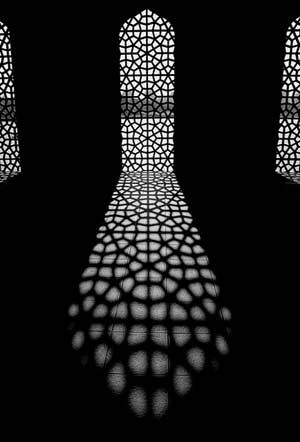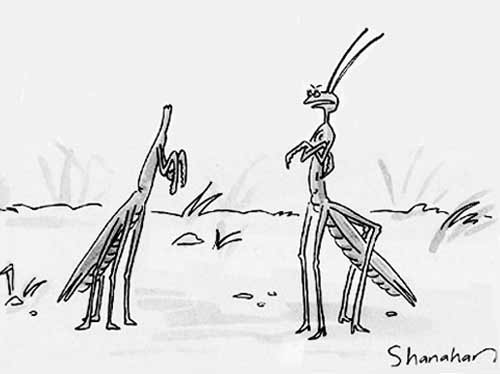Scorpions are largely solitary, nocturnal arachnids that glow bright cyan-green under ultraviolet light. Biologist Douglas Gaffin’s team “blindfolded” scorpions, then tested them with various different colours of light and found that the tails seem to function like secondary eyes. The shell works as a whole-body sensor which relays information about light to the nervous system — so any part of a scorpion can see. The cuticle (casing) seems to function as a light collector. Scorpions could use the information to detect shelter and blocking any part of the cuticle could diminish that signal.
Think of all the years passed by in which you said to yourself, “I’ll do it tomorrow”
and how the gods have again and again granted you periods of grace of which you have not availed yourself.
It is time to realise that you are a member of the universe, born of nature itself.
Know that a limit has been set to your time.
Resistance Is Futile
Jan. 19, 2012
| The Pennsylvania Game Commission, which will dispatch injured deer in or beside the road, would not come for days for an animal that, like this injured doe, posed no road hazard. So we called the local police. The officer who responded was friendly and sympathetic. I mentioned that I had grown up with a rifle and was a pretty good shot, but added that I had been a war resister back in the Vietnam War. “Well, I was no war resister,” the ex-Marine cop said, with a wry smile. He added, “I think we had to go in after Saddam Hussein.” “Yeah, well, there never were any of those weapons of mass destruction,” I said, “and it doesn’t look like the US invasion accomplished much. Iraq is a mess now, headed towards ‘failed state’ status, and Iran has much more influence there now than the US does.” He replied, as he was climbing into his vehicle to leave, “Well, it doesn’t matter. I think Israel will be taking care of Iran before long.” As he drove off, even as I mourned our doe, I was left thinking about his last remark. What was he thinking? If Israel were to “take care of” Iran, it would be by massively bombing Iran’s military installations, and no doubt much of its industrial infrastructure too, much of which is, of course, located in heavily populated areas. Thousands of innocent Iranian civilians, including children, would inevitably be killed or maimed or orphaned. This is apparently all okay with this officer who was quite visibly upset at having to stare down his gunsight into the eyes of a deer he was going to kill even for a perfectly humane reason. How strange that we as humans can be so sensitive and warm-hearted about an animal, yet detached from reality and compartmentalised in emotions and morals that we simply dismiss as “collateral damage” the lives of tens, hundreds or even thousands of innocents for calculated geopolitical reasons of dubious merit. [The policeman bore more blame personally for the death of the doe. Higher authorities than he would shoulder the blame for deaths in war. How could HE know whether or not it was justified? (How can any of us know?) They would tell him what to do.] |
||
| Robots do dull, dirty, or dangerous jobs with dispassion. In Japan, about 4% of workers are robots, given their labour shortage. But how does it affect unit cohesion if humans work alongside robots that might be equipped with cameras to record their every action? Should any robots who might be in the service of national intelligence interact with society at large, they would need to comply with society’s laws, such as rules of the road, or sharing airspace and waterways. What about the legal obligation to assist others in need (Good Samaritan Law, international law requiring ships to assist vessels in distress)? Should unmanned surface vehicles or robotic boats stop and save the crew of a sinking ship? This was contested in World War 2 in the Laconia incident when submarine commanders refused to save stranded sailors at sea because surfacing to rescue anyone would reveal the sub’s position. Might not the same thing apply to unmanned underwater vehicles (UUVs) and unmanned surface vehicles (USVs)? Another potential problem is that while microbots may look like harmless insects and birds that peek into your window or crawl into your house, they can also be outfitted with the ability to detect faces from a distance and drugs or weapons under clothing or inside a house. This blurs the distinction between surveillance and search (though a search generally requires a judicial warrant and surveillance usually not). And how do we clean the environment of used-up microbots? They can be quite tiny and can be ingested or even inhaled by animals or people. They can contain hazardous materials (mercury, battery chemicals); and not just on land, but underwater and in space, litter will accumulate. Lastly, technology dependency may result in a loss of human skill. [For some. Hasn’t it ever been thus?] Over 50 nations currently have, or are developing, military robots. |
||
Detainees
- Murat Kurnaz was the son of Turkish immigrants who had gone to Germany in search of work. In Germany, his father landed a job in a Mercedes factory. In 2001, at the age of 18, Murat married a devout Turkish woman; he wanted to learn more about Islam to lead a better life, so he decided to travel to Pakistan to study the Koran with a religious group there. He made his plans just before 9/11. Naïvely thinking war in Afghanistan would have nothing to do with Pakistan or his trip, he went ahead. Much later, when his public bus was headed for the airport where he was to return to Germany, police stopped it. As he was the only non-Pakistani on the bus, police asked him to step off, show his papers, and answer a few questions. They assured him he’d soon be on his way. But after a few days, the Pakistanis turned him over to American officials. He was taken to Kandahar, Afghanistan, where American interrogators asked him the same questions for weeks: Where is Osama bin Laden? Was he with Al Qaeda? No, he told them. No, he had no idea where bin Laden was. He begged them to call Germany. During interrogations, his head was dunked under water and he was stomach-punched. At one point, he was chained to the ceiling and hung by his hands for days. THEN he was sent to Guantánamo. Five years later, the German government secured his release. He was never charged with anything. [They may have been suspicious of why a man of Turkish descent would fly over Turkey to go study the Koran in much-more-distant Pakistan.]
- US president Obama has said, “...section 1021(e) [of the National Defense authorisation Act (NDAA)]... may not be construed to affect any 'existing law or authorities relating to the detention of United States citizens, lawful resident aliens of the United States, or any other persons who are captured or arrested in the United States.’ My administration strongly supported the inclusion of these limitations in order to make clear beyond doubt that the legislation does nothing more than confirm authorities that the Federal courts have recognised as lawful… Moreover, I want to clarify that my Administration will not authorise the indefinite military detention without trial of American citizens. Indeed, I believe that doing so would break with our most important traditions and values as a nation. My administration will interpret section 1021 in a manner that ensures that any detention it authorises complies with the Constitution, the laws of war, and all other applicable law.” But the NDAA is still less-than-wonderful because it forbids the funding to close GITMO, the bill’s language is predisposed toward indefinite detentions, and a subsequent adminisatration could feel differently about applying the law to US citizens.
- Algerian Lakhdar Boumediene was held in Guantánamo for 7 years without explanation or charge. It was only after the US Supreme Court ordered the government to defend its actions before a federal judge that he was finally able to clear his name and see his two daughters again. Boumediene worked in Bosnia, Sarajevo, as director of humanitarian aid for children who had lost relatives to violence during the Balkan conflicts. In 1998, he became a Bosnian citizen. But an intelligence officer came to his work and asked him to come in for questioning. The US thought he might have been plotting to bomb the US embassy in Sarajevo. He was flown to Guantánamo and kept there until the Supreme Court ruling. After a review of “secret” evidence Boumediene was not allowed to see, the US was ordered to release him and fly him home. He is now trying to rebuild his life. About 90 prisoners have been cleared for transfer out of Guantánamo, some from countries like Syria or China where they would face torture if sent home — or Yemen, which the US considers unstable. And so they sit as captives, with no end in sight — not because they’re dangerous, not because they’ve attacked America in intent or deed, but because the stigma of Guantánamo means they have no place to go. Yet America will not give a home to even one of them.
| Shale gas is touted as a cleaner form of energy; with its contribution to the economy, those in favour of recovering this type of resource argue that it could cut global dependence on OPEC. Yet “fracking,” a crucial part of shale gas extraction, is considered dangerous and its impact on the environment concerns many. Natural gas from shale may create 870,000 US jobs and add $118 billion to the US economy over 4 years. (The American Chemistry Council estimates 400,000 jobs, while environmental groups say more like 6,656 jobs.) Large amounts of natural gas are extracted from deep shales (usually 4,000-12,000 feet below the surface) using water and sand. Some believe that only 10% of most shale gas fields are recoverable and that US shale reserves may last only 7 years compared to the 100-year figures that many tout. Mud is pumped through drill shaft holes at 5,000 pounds per square inch to fracture the rock with hairline cracks up to 1,000 feet from the pipe. Groundwater can be contaminated from fracking water if the drill shaft leaks. Fires and explosions at drilling sites are not uncommon. Escaping gas may contaminate aquifers. Sometimes small earthquakes occur (but the same can be said of geothermal energy exploration or projects to sequester carbon dioxide underground). Nevertheless, over 30 American states are currently producing or are exploring for shale. China is likely to see a shale gas boom soon. |
||
| The future of aviation fuel may be growing on trial plots in northern Australia. Scientists there are searching for new means of keeping the world’s airliners aloft. The Australian government science agency CSIRO and America’s Boeing have launched a study to evaluate the potential to turn biomass into climate-friendly aviation fuel. The programme is tied to CSIRO’s Flight Path to Sustainable Aviation roadmap, which envisages a transtasman biofuel sector that could save the two countries billions of dollars a year. It would replace petroleum-based fuels and also create a potential for exporting new engineering know-how. Aviation fuels made from biomass have been certified and are being used on commercial and military aircraft, so the challenge now is to find the right way to scale up feedstock production so these new fuels are both environmentally and economically sustainable. Over the next year Australian researchers will assess the potential of biomass production systems based on feedstocks such as grasses and short-rotation trees in combination with grazing or cropping in regional Queensland. They will also assess the technology needed to turn the feedstocks into jet fuels, and find production systems and technology that are compatible with local infrastructure. By using a variety of non-food biomass resources and sustainable practices for growing them, there could be sufficient biomass to support almost half of the aviation fuel needs of Australia and NZ by 2020 and more than 100% by 2050. The two countries could save more than A$2 billion (NZ$2.27 billion) a year on jet fuel imports and achieve a 17% annual reduction in aviation greenhouse gas emissions. |
||
Trying to Get It Right
- A favorite pedagogical device of US-presidential-candidate Ron Paul is to analogise foreign situations to American ones. A campaign ad promoted by a Paul-supporting super PAC begins by asking us to imagine Russian or Chinese troops in Texas. The point is that this is how our occupations of Iraq and Afghanistan look to locals. A big problem in the world is the failure of “moral imagination” — the inability or unwillingness of people to see things from the perspective of people in circumstances different from their own. Especially incendiary is the failure to extend moral imagination across national, religious, or ethnic borders. If a lack of moral imagination is indeed the core problem with America’s foreign policy, and Ron Paul is unique among presidential candidates in trying to fight it, he may be doing something great, notwithstanding the many non-great and opposite-of-great things about him (and notwithstanding the fact that he has in the past failed to extend moral imagination across all possible borders). Paul’s hawkish detractors may succeed in using him to taint a non-interventionist foreign policy. Even so, if in the meanwhile Paul gets enough people exercising their moral imaginations, maybe doves will get the last laugh.
- Deficit-worriers portray a future in which Americans are impoverished by the need to pay back the money they’ve borrowed. They see America as like a family with too large a mortgage who’ll have a hard time making monthly payments. This is a bad analogy in at least 2 ways. First, families have to pay back debt — governments don’t. All they need is to ensure debt grows slower than the tax base. The debt from World War II was never repaid — it just became increasingly irrelevant as the economy grew (as did income subject to taxation). Second, an over-borrowed family owes money to someone else; US debt is, to a large extent, money owed themselves. This was true of debt incurred to win World War II — taxpayers were on the hook for a debt significantly bigger as a % of GDP than today; that debt was also owned by taxpayers (people who bought savings bonds) so it didn’t make postwar America poorer. In particular, it didn’t prevent the postwar generation experiencing the biggest rise in income and living standard in the nation’s history. But isn’t this time different? Not so much. It’s true that foreigners now hold large claims on the US, including a fair amount of government debt. But every $ worth of foreign claims on America is matched by 89¢ of American claims on foreigners. Foreigners tend to put their US investments into safe, low-yield assets, so America actually earns more from assets abroad than it pays to foreign investors. If your image is of a nation deep in hock to the Chinese, you’re misinformed. Nor is the US speeding in that direction. So yes, debt matters. But other things matter more. America needs more, not less, government spending to get themselves out of the unemployment trap. Wrongheaded, ill-informed obsession with debt stands in the way. [That and the fact that debt in the US is growing faster than the economy, and the US is currently on the road to ruin.]
- It would be one thing if the substance of the attacks on GOP presidential hopeful Mitt Romney had to do with an ethical problem at Bain Capital or some type of personal association. This is not to say that voters would have no right to consider the issue, but it would be peripheral to the core economic message of Mr Romney’s campaign. But these attacks take a different tack. They are a critique of Bain Capital’s business model and, by extension, a critique of a certain form of free-market activity that many Republicans advocate. The ad, When Mitt Romney Came to Town, a 28-minute commercial put out by a super PAC that backs Newt Gingrich, adopts what appears to be a documentary style, but presents a one-sided view of the role played by private equity companies, characterising them as greedy, lining the pockets of the wealthy at the expense of the working class. Determining how many jobs Bain Capital created or destroyed during Romney’s tenure is incredibly challenging. Some companies were in a state of financial distress. If, for instance, Bain Capital invested in a company and reorganised it, trimming 2,000 jobs in the process, but the company might have shuttered entirely and shed 6,000 jobs without intervention, how should that be scored? Or what if it invested in a business that was on an upward trajectory, and the job gains came despite, rather than because of, Bain Capital’s intervention? Rick Perry of Texas, former head of the Republican Governors Association, describes Mr Romney as a “vulture capitalist.” But vultures are equipped by evolution and nature with quite good tools to eat dead and dying critters. It’s a useful niche.
| Only one country in the Middle East has nukes: Israel. Israel has not signed the non-proliferation treaty and has already bombed two other states (Iraq, Syria) who were attempting to acquire a nuclear deterrent to rival Israel’s own. To ascribe genocidal motives to civilian scientists is to look inside a person’s soul. Perhaps the assassinated scientists believed, as the Green Movement does, that Iran’s nuclear programme should be pursued out of patriotism and national pride rather than genocide. But David Frum knows better: “These scientists were actively engaged in developing instrumentalities for genocide.” Really? Larison provides a reality check: “Israel has a nuclear deterrent of hundreds of warheads that should present Iran from attacking it even if Iran had a nuclear weapon — and there’s still no evidence that the Iranian leadership has decided to develop one. They seem intent on self-preservation of their regime rather than on mass suicide. Plus, the official Iranian position is that the use of nuclear weapons is forbidden by Islamic law. On the basis of a (fantasy?) fear of an Iranian nuclear first-strike attack on Israel, Tobin sanctions the murder of people who may be involved in nothing more than legitimate scientific research. “They must be stopped before they kill,” he says, but there’s no reason to think that “they” are going to do the killing he fears. And it goes without saying that these acts are not concerned with American or Israeli self-defense. |
||
| “Buy now, pay later” has long been the unofficial mantra of American retailing. But this holiday season some American shoppers have gone the other way — paying first and buying later. Even people who can pay off their credit cards often don’t, since the whole structure of the credit-card industry is designed to make you irresponsible — as long as you make a small monthly payment, the bank will carry you. In fact, that’s what the bank wants: the profits in the credit-card business come from “revolvers,” people who pay a small amount each month and rack up big interest charges — far more than the 5 bucks they’d have spent on a layaway service fee. Layaway, by contrast, fosters virtue: it forces you to save, because if you don’t make the payment you don’t get the product. It’s what psychologists call a “commitment device,” a way to get yourself to do something that you want to do but know you’ll have a hard time doing if left purely to your own devices. It’s common to think of American consumers as reckless dupes, myopically focussed on the present and easily led astray by their desires, with the buying binge of the years leading up to the crash proffered as Exhibit A. But consumer choices don’t occur in a vacuum; they’re always shaped by social and economic norms. Via Andrew Sullivan, The Dish. |
||
Geosynchronous? Or Geostationary?
- In general, all geostationary orbits are geosynchronous, but not all geosynchronous orbits are geostationary. Geosynchronous means that a satellite makes one orbit every 24 hours so that it is synchronised with the rotation period of the earth. This will happen when a satellite is in a circular orbit at a rough distance of 36,000 kilometres above Earth’s surface or roughly 42,000 kilometres from Earth’s centre. However, to be a geostationary satellite, the geosynchronous satellite must be in orbit in Earth’s equatorial plane — geostationary is a small subset of the orbits that are geosynchronous. The orbital location of geostationary satellites is called the Clarke Belt in honour of Arthur C Clarke, who first published the theory of locating satellites in Earth’s equatorial plane for use in fixed communications.
- In recent years, "parking spots" in the geosynchronous orbit (GSO) have become an increasingly hot commodity. According to the National Aeronautics and Space Administration, since the launch of the first tv satellite into a geostationary orbit (a circular prograde orbit in the equatorial plane with an orbital period equal to that of the earth achieved with an orbital radius of 6.6107 equatorial Earth radii, or an orbital height of 35,786 kilometres) in 1964, the number of objects in Earth’s orbit has steadily increased to over 200 new additions per year. This increase was initially fuelled by the Cold War, during which space was a prime area of competition between the US and the Soviet Union. Yet over two decades after the end of their space race, even the global financial crisis that began in 2007 does not seem to have diminished the demand for telecommunications satellites positioned in GSO. This ongoing scramble has prompted some developing equatorial countries to assert sovereignty over the outer space “above” their territorial borders, presumably with the hope of extracting rent from developed countries that circulate their technologies overhead. So far, the international community has rejected this notion, but the legal status of the GSO remains in limbo. Who owns it? This is a question that will be hammered out by space lawyers in courts.
| Secrecy is the art of telling a thing to only one person at a time. |
||
| In 1965, scientist Martin Seligman attempted to expand on Pavlov’s research (Pavlov’s dogs learned to salivate when they heard a bell ring). Seligman rang a bell, then zapped the dogs with electricity rather than feeding them as Pavlov had done. To keep the dogs still, he restrained them in a harness during his experiments. After the dogs were conditioned, he yoked then together into two sets of dogs by these harnesses. He zapped each set at random intervals. But for the first set, any of those dogs could hit a lever which would stop the charge for all of them. The other set of dogs found nothing happened when any of them pressed the lever. The second group was dependent on the first set of dogs to do something randomly to stop the charge. In phase 2, the dogs were all unyoked and put on one side of a container divided by a climbable fence. The side they were on received a shock. All the dogs had to do was climb the fence to get away. Those that had found the lever responsive jumped the fence. Those who had found it unresponsive dropped to the ground. Dogs who had never been zapped before jumped the fence. Not in control of your destiny? Give up and accept whatever situation you’re in! When battered women, hostages, abused children, or long-time prisoners refuse to escape, like the dogs, they’ve accepted the futility of trying. If they do get out of their present situation, they seem to focus rather hard on avoiding failure for some time afterward. Dogs do that too? Being aware of this lay-low tendency may allow better self-control. |
||
Medical Life
- Medicaid often pays for emergency care for illegal immigrants, but not for continuing care. Many hospitals in places with large concentrations of illegal immigrants (Texas, California, Florida) face the quandary of where to send patients well enough to leave but not able to look after themselves. Officials in New York City say they have many such patients who are draining money from the health system. Even if Medicaid pays for some of their care, taxpayer dollars are ultimately consumed by patients who could be cared much more cheaply in nursing homes or similar health facilities — even at home if supportive services were available. Care for a patient languishing in a hospital can cost more than $100,000 a year, while a nursing home might be only $20,000 (or even less). Patients who could be discharged from hospital but have no place to go typically remain an extra 5 years (or more). There are at least 300 patients in such a predicament throughout New York City. One patient, a former hospital technician from Queens, has lived at the specialty hospital on Roosevelt Island for 13 years because the hospital has no place to send him. The patient is in his mid-60s, there since an arterial disease cost him part of one leg below the knee and left him in a wheelchair.
- Hospital employees recognise and report only 1 of 7 errors, accidents and other events that harm Medicare patients while they are hospitalised, federal investigators say. Yet even after hospitals investigate preventable injuries and infections that have been reported, they rarely change their practices to prevent repetition of “adverse events,” according to the study by the inspector general of the Department of Health and Human Services. As a condition of being paid under Medicare, hospitals are to “track medical errors and adverse patient events, analyse their causes” and improve care. Nearly all hospitals have some type of system for employees to inform hospital managers of adverse events, defined as significant harm experienced by patients as a result of medical care. Despite the existence of incident reporting systems, hospital staff did not report most events — even some that caused patients to die. Seminal events include medication errors, severe bedsores, infections that patients acquire in hospitals, delirium resulting from overuse of painkillers and excessive bleeding linked to improper use of blood thinners. Federal investigators identified many unreported events by having independent doctors review patient records. It was estimated that in the US, more than 130,000 Medicare beneficiaries experience one or more adverse events in hospitals each month.
- Through the National Institutes of Health (NIH), American taxpayers support research directed at understanding and treating human disease. For more than 2 years, research results have been available for free here. After all — American tax dollars helped pay for it. But a bill introduced in the House of Representatives may stop that. If it passes, the NIH can no longer require grantees to provide copies of papers they publish in peer-reviewed journals. Then, the results of federally funded research will cost US$15-30 each to read. (Pay me now, pay me later.) There’s an ongoing battle between the publishers of biomedical research journals like Cell, Science and The New England Journal of Medicine, who (of course) seek to protect their valuable franchise, and the researchers, librarians and patient advocacy groups, who seek to provide open access to publicly funded research. The value journals add lies primarily in peer review, the process through which works are assessed for validity and significance before publication. But the journals don’t pay the reviewers — often the taxpayer does if salaries are publically funded through grants.
| A recurring refrain from China these days is that America’s strength comes not from its democratic and free-market values, but merely from the size of its economy and the power of its soldiers and weapons. There is nothing universal about America’s democratic and economic ideals, Chinese officials insist. Democracy is a relative concept, and markets have a centuries-old habit of spinning out of control. The US remains a superpower only because its economy remains on top. Soon, they warn, this advantage will be gone. The US does face formidable challenges. Spiralling federal debt, high unemployment, and lower real wages have taken their toll on its self-esteem. For the moment, Republican demands for smaller government have made new stimulus spending all but impossible. The new century began with contested ballots and a presidential election decided in court, a spectacle that made it harder for Americans to champion democracy abroad. The 11 September attacks generated support around the world, but the opening of Guantánamo Bay prison, the Abu Ghraib scandal, and civilian deaths following US drone attacks inside Pakistan have done lasting damage to America’s ability to defend international law and human rights. As the US economy struggles to restore lost jobs, China has rebounded. Yet China’s tens of thousands of protests each year suggest a yearning for something beyond stability and state-driven growth. Like demonstrators in Russia, Syria and elsewhere, they want responsive governance, a chance to create their own wealth, and a system that respects their rights and extends their freedoms. |
||
| Reason has cast a gimlet eye on the White House’s We the People petition site before. (See Peter Suderman’s 5,000 Signatures Will Get You a Response From White House Policy Wonks, Unless Your Idea is Bad or About Weed.) But some enterprising citizens have taken the position of questioning the idea even further, submitting this petition on the site:
|
||
Christchurch and Earthquakes
- The Canterbury region is located on the boundary between the Pacific and Australian plates; its surface expression is the active right lateral Alpine fault. Beneath the North Island and the northern part of the South Island, the Pacific plate subducts obliquely under the Australian plate, while at the southwestern part of the South Island, a reverse process takes place. Although New Zealand has experienced several major earthquakes in the past as a result of its complex seismotectonic environment, there was no evidence of prior seismic activity in Christchurch and its surroundings before the September event. The Darfield and Christchurch earthquakes occurred along the previously unmapped Greendale fault in the Canterbury basin, which is covered by Quaternary alluvial deposits.
- The 22 February 2011 aftershock, at approximately US$15 billion in damage, is New Zealand’s costliest natural disaster ever. Poorly consolidated, low-shear-wave-velocity soils liquefy during shaking.
- Canterbury region earthquakes since 4 September 2010:
| Magnitude | Range | |
|---|---|---|
| 7.0+ | 1 | |
| 6.0 — 6.9 | 3 | |
| 5.0 — 5.9 | 39 | |
| 4.0 — 4.9 | 374 | |
| 3.0 — 3.9 | 2,773 |
This information is current through 16 January 2012.
- The Canterbury earthquakes of 2010-2011 produced some of the strongest ground motions ever measured in New Zealand. Many of the highest acceleration recordings arose from seismic stations within the city of Christchurch (population ∼377,000). A dense array of strong-motion seismometers was in place prior to the mainshock of 4 September 2010. Subsequent to the mainshock, numerous rapid response accelerometers were installed in the Canterbury Plains, Banks Peninsula, and in the city itself. The 22 February aftershock was one of the best-recorded shallow thrust earthquakes in the near field. Recorded peak ground acceleration (PGA) exceeded 2g near the epicenter and greater than 0.6g over much of the central and eastern suburbs.
- A statistical analysis published by GNS Science on 15 December shows a 50% chance of a tremor between 5.5 and 5.9 occurring in 2012. When faults have been locked up for 5-10 thousand years, 3 months without a major earthquake is the blink of an eye in geological terms. After a magnitude 6 quake a region can expect around 10 magnitude 5 aftershocks. The deeper rock around Christchurch is quite firm, even though it has river gravels on top. When it breaks, the break happens rather violently. When a fault been locked for a very long time, it takes a while to rid itself of all the built-up stress.
| What’s This? This image captures 6 months (21 June-22 December) of the sun in one pinhole camera exposure. The summer solstice is the line at the top while the winter solstice is the lowest line. |
||
| New rules for long-haul passenger planes will allow extended-range Boeing 777 and 787 Dreamliner planes to fly over the North Pole, cutting flight times and fuel costs. The new rules come after US aviation authorities allowed an increase in the maximum distance a plane can stray from a diversion airport — from 3 hours’ flying time to to 5½ hours’ — in case of engine failure. Air New Zealand is the first airline to take advantage of the extended operations rules, with its Los Angeles to Auckland flights launched this month. Chief pilot David Morgan said the rules meant an aeroplane was able to fly a more direct route between two cities, which was good for the environment. “Less fuel is burned and less carbon dioxide is emitted into the atmosphere. It’s also good for customers because flights are potentially shorter and passengers could arrive sooner at their destinations.” Although Air New Zealand does not currently fly over the North Pole, the extended operations rules would make that a possibility for future routes. It would allow long-haul planes to fly non-stop from Britain to the Pacific without a stopover, cutting across the Arctic. |
||
Three Short, Worthwhile Videos
- This cube made of gears is an example of an item produced by 3D printing; it’s a phenomenon on Thingiverse, where the method for turning any solid shape into a geared wonderment has been generalised into a formula that can be applied to your 3D model file.
- A team of scientists has demonstrated that a coordinated group of pre-programmed, autonomous robotic helicopter bees can do the job of building workers, constructing a 6-metre-high tower without human intervention. They are programmed to interact, lift, transport and assemble small modules in order to erect a building structure that synthesises a rigorous architectural approach. This technology may pave the way for new methods of engineering buildings of the future.
- A simple demonstration of eddy current braking shows neodymium magnets being dropped through a copper tube. [It almost seems to have an antigravity effect.] Keep in mind that copper is not ferromagnetic, and there’s no direct magnetic attraction involved. Eddy current brakes slow an object by creating eddy currents through electromagnetic induction which creates resistance. Modern roller coasters incorporate this type of braking utilising permanent magnets instead of electromagnets in order to avoid the dangers of potential power outages.
| A desktop machine not much bigger than a microwave that can in one day decode the entire three billion “letters” of the human genome for just US$1,000 (NZ$1,260) has been built, bringing nearer the possibility of routinely sequencing a person’s entire DNA. Who will be able to access the results? Doctors and their patients, insurance companies, employers, [or even the police?] may have a vested interest in knowing about a person’s genetic predispositions. Whatever. This won’t be stopped. Do I want to know my genetic destiny? We once could just look at the elder members of our extended families. But families are more scattered. The Ion Proton™ Sequencer is priced at US$49,500. It analyses a single genome in one day on a standalone server, eliminating the informatics bottleneck and high-capital IT investment associated with optical-based sequencers (which can take weeks to complete). The huge variation in human genome sequence between individuals has always been an obstacle to understanding how to use sequence information to improve human health. That should change quickly. |
||
|
||
Too Free with the Parking
Take parking lots seriously. There are said to be at least 105 million and maybe as many as 2 billion parking spaces in the United States. A third of them are in parking lots, those asphalt deserts that we claim to hate but that proliferate for our convenience. One study says we’ve built 8 parking spots for every car in the country. Houston is said to have 30 of them per resident. In Rethinking a Lot, a new study of parking, Eran Ben-Joseph, a professor of urban planning at MIT, points out that “in some US cities parking lots cover more than 1/3 of the land area, becoming the single most salient landscape feature of our built environment.” Absent hard numbers Ben-Joseph settles on a compromise of 500 million parking spaces in the country, occupying some 3,590 square miles, or an area larger than Delaware and Rhode Island combined. If the correct number is 2 billion, we’re talking about 4 times that: Connecticut and Vermont. Either way, it’s a lot of pavement. we continue to produce parking lots, in cities as well as in suburbs. On the right, the Minimalist museum located on New York’s Hudson River treats parking lots the way people actually experience them: as the real entrance to a building. This parking lot was designed by artist Robert Irwin in collaboration with the firm OpenOffice. I saw many parking lots like this in North Carolina when we lived there, and even some in New Jersey, both places with high summer humidity coupled with high summer temperatures. Touching a car which has been sitting in the overhead sun can raise blisters — being able to park in shade can make an otherwise intolerable situation acceptable. (Some green design is in reality self-serving.)
| “In our day-to-day lives, we are always trying to manipulate or otherwise act on our surroundings, whether by turning a car’s steering wheel or frying an egg or clicking on a link at a website. But when we open a book, our expectations and our attitudes change drastically. Because we understand that “we cannot or will not change the work by our actions,” we are relieved of our desire to exert an influence over objects and people and hence are able to “disengage our [cognitive] systems for initiating actions.” That frees us to become absorbed in the imaginary world of the literary work. We read the author’s words with “poetic faith,” to borrow a phrase that the psychologically astute Coleridge used two centuries ago. We gain a special trance-like state of mind in which we become unaware of our bodies and our environment… The central subject of literature is society, and when we lose ourselves in a book we often receive an education in the subtleties and vagaries of human relations… [R]eading tends to make us more empathetic, more alert to the inner lives of others. The reader withdraws in order to connect more deeply.” — Nicholas Carr Via Andrew Sullivan. |
||
| The US National Weight Control Registry tracks 10,000 people who have lost weight and have kept it off. Anyone who has lost 30 pounds and kept it off for at least a year is eligible to join the study, though the average member has lost 70 pounds and remained at that weight for 6 years. Physiological changes probably do occur that make permanent weight loss difficult, but a larger problem is environmental. People struggle to keep weight off because they’re surrounded by food, inundated with food messages and constantly presented with opportunities to eat. There is no consistent pattern to how people in the registry lost weight — some did it on Weight Watchers, others with Jenny Craig, some by cutting carbs on the Atkins diet and a very small number lost weight through surgery. But their eating and exercise habits appear to reflect what researchers find in the lab: to lose weight and keep it off, a person must eat fewer calories and exercise far more than a person who maintains the same weight naturally. Registry members exercise about an hour or more each day — the average weight-loser puts in the equivalent of a 4-mile daily walk, 7 days a week. They get on a scale every day in order to keep their weight within a narrow range. They eat breakfast regularly. Most watch less than half as much tv as the overall population. They eat the same foods and in the same patterns consistently each day and don’t “cheat” on weekends or holidays. They also appear to eat less than most people, with estimates ranging from 50 to 300 fewer daily calories. These people are incredibly vigilant about maintaining their weight. Years later, they are still paying attention to every calorie, spending an hour a day on exercise. They never don’t think about their weight. |
||
Beautiful Botannicals
- Wisteria tunnel.
- A pair of yew trees flanking St Edward’s church door.
- Moreton Bay Fig Tree from about 1910. It’s 78 feet (24 metres) high, with a crown width of 123 feet (37 metres) and a trunk girth of 40.5 feet (12.3 metres).
- A tree and its roots (species unknown) in Tainan, Taiwan.
- The root begins under the sidewalk; the leaves begin up on the roof. In Sant’Alfio, Sicilia.
- A very old apple tree, Long Island, New York.
- An Aurland Kommune cabin with a sod roof.
- The ACROS Fukuoka building was constructed on the last remaining green space in the city centre, so the architects created a design to preserve the green space as much as possible, while still fitting in a large office building. In addition, the green roof reduces energy because it keeps the inside temperature more constant and comfortable; it captures rainwater runoff; it supports the life of insects and birds. The garden terraces contain 35,000 plants representing 76 species. The terraced south façade is utilised by many in the area for exercise and rest, affording views of the city and the harbour beyond. [I’d like to know how this design impacts long-term maintenance costs. It seems like such a good idea, I assume there’re valid reasons why it isn’t done more often. No doubt higher upfront costs.] More photos and more info on its cooling effect if you’re interested.
- The School of Art, Design and Media is situated in a wooded valley right in the heart of the campus. The structure encloses a picturesque plaza. Major spaces such as the auditorium, media studios, library and art galleries are in the buildings tucked underneath as are complementary facilities such as a stop motion studio, a 3D high-end computer graphics studio, a soundstage, sound recording studios, audiovisual editing suites, high-end digital post studio and others. The highlight is the verdant turfed roof which blends with the ground contour. Apart from its visual impact, the roofscape is a functional space accessible via sidesteps along the roof edge. It serves as a scenic outdoor communal space that also helps control the temperature inside the covered buildings and in the surrounding neighbourhood. [I wonder how mowing is done.] Oddly, the view from inside seems to show nothing green whatsoever.
| How common is your birthday? A curious table shows every day of the year, from 1 January to 31 December, along with a ranking based on how many babies were born in the US on that date between 1973 and 1999. The 16th of September has proven to be the most common birthday. Via The Dish. |
||
| Federal officials have issued a warning to a California man who has been donating cups of his sperm to women who want kids. Trent Arsenault says he got 3 women pregnant last month, a record for the 36-year-old Fremont father of 14 — and counting. Arsenault says he considered donating through sperm banks, which offer money and donor anonymity but he decided to give it away in sterile cups so he can meet the future parents. The US Food and Drug Administration has now told Arsenault he’s facing a $100,000 fine or up to a year in prison for ignoring federal regulations requiring blood tests to screen for communicable diseases (“within five (5) working days from receipt of this Order you must cease all manufacturing operations…”). [Of course, if Arsenault skipped the sterilised cups and just made a deposit the regular way, that would be perfectly legal — but then he’d miss the income from his part-time job: porn star. He films himself filling those little cups.] |
||
New Year’s Fireworks Displays
- Fireworks light up the skyline and Big Ben just after midnight on 1 January 2012. Thousands of people line the banks of the River Thames in central London.
- Fireworks explode over the Harbour Bridge and Opera House during a celebratory pyrotechnic show.
- Thousands of people watch fireworks during a New Year’s Day celebration on Red Square.
- Fireworks explode during a pyrotechnic show in the coastal city of Vina del Mar, about 121 kilometres (75 miles) northwest of Santiago, Chile.
- People watch fireworks along Copacabana Beach in Brazil.
- The first rising sun of 2012 appears above Mt Fuji, observed at Yamanashi prefecture. All Nippon Airways (ANA) organised a rising sun observation flight with 137 passengers. (Okay, this isn’t exactly fireworks, but it seems to serve the same purpose.)
New Zealand doesn’t celebrate the new year with fireworks — but they have spectacular fireworks at other times, so I’ll forgive them this lapse.
| Coordinated Universal Time (UTC) is a standard agreed to in the 70’s which is used all around the world, dictating what time it is in every time zone on Earth. Scientists at the International Bureau of Weights and Measures in Paris are now calling for the ageing standard to be abolished because scientists are forced to manually add “leap seconds” to keep it accurate. That isn’t precise enough for the age of electronics. UTC is an average of the times from 400 precise atomic clocks. Due to fluctuations in Earth’s rotation, UTC slowly surpasses “real” time as dictated by day and night. Leap seconds are added by holding back the atomic clocks by 1 second, usually at midnight on one night in alternating Junes or Decembers as needed to keep UTC in line. That tiny difference will one day prove disastrous. Global navigation satellite systems such as GPS have a continuous time scale without these so-called leap seconds. Currently, there exists a 15-second difference between UTC and the time GPS uses. Someone unaware of this could make a tragic mistake when landing an aircraft, for instance. Even a one-second difference between stock exchanges could provoke a gain or loss of millions of dollars. The time it takes Earth to spin slows very slightly. At the World Radio Conference of the International Telecommunication Union in Geneva beginning 23 January 2012, scientists will debate whether to continue adding leap seconds to the standard — or to let Earth’s time diverge, and thus let our electronics work. |
||
| A new, leap-year-free calendar, the Hanke-Henry Permanent Calendar, is being proposed that would have birthdays, holidays and Christmas fall on the same day every year (this differs from the Gregorian calendar currently in use in the West). The Gregorian calendar (a reform of the older Julian calendar) was first introduced by Pope Gregory XIII in 1582. In a leap-year-free calendar, each year is 364 days long. Every 5 or 6 years, a week-long mini-month keeps the calendar in tune with the solar cycle. Its sheer predictability would save the economy billions and could save money for individuals as interest calculations would no longer be rounded up by lenders. The 7-day work week would remain intact. In addition, September would have 31 days as would March, June and December. All the rest would have 30. The Gregorian calendar is the most common internationally. The Hebrew calendar is official for Israel and the Jewish faith: the beginning of each month is determined by a new moon. By tradition, days of the week (sunset to sunset) are designated by number; only the 7th day, Sabbath (sunset Friday to sunset Saturday), has a specific name. Each year is 12 or 13 months; months have 29 or 30 days. The Islamic calendar is lunar, consisting of 12 alternating months of 30 and 29 days, with the final 29 day-month extended to 30 in leap years. The calendar began on Friday 16 July 622 CE, marking the day of Prophet Muhammad’s flight from Mecca to Medina, with sunset on the preceding day reckoned as the first day of the first month of year 1AH—'Anno Hegiræ’ — Arabic for “separate”. The Chinese calendar is lunisolar, based on positions of the sun and moon. Months of 29 or 30 days begin on days of astronomical new moons, with an extra month added every 2 or 3 years. Although the Gregorian calendar is used in the Peoples’ Republic of China, for administrative purposes the traditional one is used for festival dates and timing agricultural activities. The modern Persian calendar was adopted in 1925, taking over a traditional calendar dating from the 11th century. It consists of 12 months, the first 6 of which are 31 days, the next 5 are 30 days, and the final is 29 days in a normal year and 30 in a leap year. Each year begins on the day of the March equinox. Days begin at midnight, standard time. |
||
In Which Time Zones Do the Most, and the Least, People Live?
The answer to that should be easy since ALL China along with Taiwan, Hong Kong, the Philippines, Malaysia, Singapore, Brunei, Timor, part of Indonesia, part of Siberia, and the western third of Australia, are in the same zone. They can all celebrate New Year’s together. The emptiest zone contains about 2/5 of Greenland, a small part of easternmost Brazil, and the Azores — though they have all attached themselves to adjacent timezones instead. It is estimated that 25 or so people live in the least populated zone. From the comments: Samoa had a shorter 2011 than anybody else — they skipped Friday, 30 December and thus went from being the last to experience the new year to being the first. This gives them the distinction of having had a single 364-day year.
| Kids should learn piano and/or guitar. Either will serve them well throughout their lives — and if they want to learn both, hooray! If, after becoming proficient in one, older kids choose to pick up the flute or the drums or the cello, congratulations: you now have a young person with a fundamental understanding of how music works and the curiosity to explore further. Nothing against the other instruments — they just don’t belong in the hands of children and shouldn’t be anyone’s first instrument. Screenwriter John August started playing clarinet in 3rd grade. He says success at clarinet doesn’t translate to music as a whole — he never learned chord progression, because a clarinet plays only one note at a time. He forgot how to read bass clef because clarinet is written in treble. He only knew how to make fairly pretty sounds within a narrow range of musical genres. Compare that to piano. A person can play everything on the piano. The guitar is also fundamental. Almost every song you’ve ever heard on the radio has its roots in guitar. What’s more, piano and guitar both allow one to sing while playing. Songs have words. Piano and guitar let them be used. A kid who learns to play piano or guitar proficiently will be able to play socially for his/her entire life. Moreover, the piano/guitar kid will have a better sense of chords and polyphonic structure than the kid who only plays violin. [The school’s marching band would then the butt of a lot of jokes.] |
||
| Despite a widespread belief in the old violins’ superiority and despite the millions of dollars it now costs to buy a Stradivarius, the fiddles made by the old masters do not, in fact, sound better than high-quality modern instruments, according to a blindfolded play-off conducted by an expert on violin acoustics at the University of Paris. Violinists attending an international competition in Indianapolis were asked to compare 3 high-quality modern violins with a Guarneri and two Stradivari instruments. The violinists had to wear goggles, so that they couldn’t identify the violins. In one test they were allowed to play all 6 violins and asked to choose which they’d most like to take home. In another, they were required to compare a pair of violins, without being told that one was a classic and the other a new instrument. Despite a general belief among violinists that Stradivari and Guarneri violins are tonally superior, the participants in the test couldn’t reliably distinguish such instruments from modern violins. Only 8 of 21 chose an old violin as the one they’d like to take home. In the old-to-new comparison, a Stradivarius came in last and a new violin as the most preferred. But a longtime member of the Juilliard String Quartet argued that the auditions took place in a hotel room, yet violinists need to assess how an instrument will project in a concert hall. He likened the test to trying to compare a Ford and a Ferrari in a Walmart parking lot. [He would, wouldn’t he?] |
||
Narrow Canyons Broaden Experience
- Réunion is part of the European Union, being one of France’s fully incorporated overseas departements. As such, it is one of the French Republic’s 26 regions, with the same status as those on the European mainland. Because Réunion is in a time zone to the east of Europe, the first-ever purchase with the EU’s new currency was made here in 2002. It is 63 kilometres (39 miles) long by 45 kilometres (28 miles) wide. Back in 1952, the greatest 24-hour precipitation ever recorded took place on Réunion — 1.87 metres (73½ inches). And 3.9 metres (154.7 inches) once fell in 72 hours. The primary river flowing through the gorge, which is up to 1,000 feet (300 metres) deep, is the Bras de Caverne River, a tributary of the Rivière du Mât.
- This is the protected landscape area of Bohemian Paradise (Český ráj) located northeast of Prague. The rock town of Prachovske Skaly was created through eroding of rectangular-shaped sandstones of the upper Cretaceous.
- Reflected light illuminates the inside of Oregon’s Oneonta Canyon, located just east of Multnomah Falls in Corbett, Oregon. Oneonta Gorge is a slot canyon with an impressive waterfall at the end. The stream spans from sheer cliff wall to sheer cliff wall; while only ankle-deep in most places, the water does get waist-high even in dry seasons. It lies next to the freeway yet a few feet into the gorge is a different world. At noon, the sun slants into the gap; the walls of the canyon are encrusted in glistening, moist moss.
| Bill Clinton arrived at the White House in 1993 with not just his appetite, but also some food allergies, including chocolate and flour. “But he loved dessert,” says former White House pastry chef Roland Mesnier. “It made it very difficult for a pastry chef.” He recalls the episode of a strawberry cake he made one evening. Clinton devoured half of it all by himself, and the next morning he wanted more. “No one could find the cake,” says Mesnier, who had a face-to-face with the distraught commander-in-chief. “Clinton was pounding on the table and shouting, ‘I want my goddamned cake.’” The chef, who is given to flights of humour, says that when the cake could not be found, “We decided [Vice President Al] Gore must have eaten it.” Mesnier was the White House pastry chef for 26 years, starting with the Carter administration and departing after the second term of President George W Bush. He’s now a lecturer and author and asserts, “Every story I tell you is true.” |
||
| In 1973, Skylab 2 astronaut Jack Lousma told Time magazine that he’d accidentally smashed a bottle of aftershave in his first days back from a month-long sojourn in space. He’d let go of the bottle in mid-air, forgetting that it would crash to the ground rather than just float there. |
||
Nature and Art: High, Medium, Low
These aren’t exactly related; they aren’t even the same colour.
- Ben Bulben was formed during the Ice age, when Ireland was under glaciers. Originally it was a large ridge. The moving glaciers shaped it into its present distinct formation.
- Painted by Tetsuya Ishida, who was struck by a train at the age of 32, presumably a suicide. His 180 or so odd surrealistic paintings do seem to indicate that he was not at all happy with modern industrial life.
- While working as a field researcher for a biodiversity study on pine plantations in North Carolina, the photographer found this Agkistrodon piscivorus in a drainage ditch displaying the classic defensive posture that gives it the common name “cottonmouth.” (It IS a poisonous snake. I, being followed by my kids and dogs, met one once in my front yard when I was living in North Carolina. It’s an experience that I still vividly remember.)
| Amoeboid yellow slime mould might seem an unlikely candidate to become the basis of future “bio computers”, but Japanese scientists say that mould shows distinct signs of intelligence. Colonies of mould appear able to organise themselves so that they take the most direct route through a maze to find food, while at the same time avoiding damage from light. The mould even appears able to remember dangers and avoid them. It’s been around for hundreds of millions of years and appears to have evolved to deal with harsh environments, a task beyond the capability of many advanced computers and software packages and a level of information processing surprising in a single-celled organism. It has already been demonstrated that the moulds can “design” a railway network similar to Tokyo’s by using their primitive navigation systems, imitating in a short time a task that took many human experts to achieve. |
||
| Before CGI, when a house needed to explode, it actually got blown up. This is from Antonioni’s failed 1970 movie, Zabriskie Point, a gallant attempt by that middle-aged European intellectual to penetrate the dreams and despairs of America’s Vietnam generation. He filmed part of it in Death Valley, California, and ended it with an explosion which sent the trophies of consumer society flying into space. The film was perhaps a failure, but of a kind that has not become less interesting through the years. |
Let’s Go Back One More Time
What would a Delorean look like if it were polished to a mirror finish? Now you know. (Apparently this took “an insane amount of time”...)
| Designed by Rochus Jacob, this rocking chair comes integrated with an OLED lamp that can provide light sufficient to read, powered only by the rocking motion. Great for when you want to read and the power’s out. When not in use, the lamp can be switched off and whatever power has been generated will be stored in the battery, which can power the lamp even when not rocking. But why didn’t they give it arms and a headrest? (I suppose those can be added.) Maybe an additional plugin could power a smartphone or an e-book reader? |
||
| At last — a clever 404 page: “Page not available. But Justin is. Justin is a Mint developer who likes slow cars, sharp crayons, reheated pizza and awkward silence. Email him at justin [ at ] mint.com. But if you’re more interested in personal finance than in Justin, try the links below… |
||
Shadows, Illusion, and Light
- I don’t know where this is. The photographer is Malasian, so perhaps that’s a clue.
- This work (by sculptor Jeanne Argent, 1990) is located in Guildford Castle’s grounds in a walled garden behind the bowling green, near the house, Chestnuts, that Lewis Carroll (Charles Dodgson) once rented nearby. He passed away in Guildford in 1898 and is buried in The Mount Cemetery.
- Toki no Sumika resort in Japan has hosted an extraordinary light display the last few years, with 3.2 million LED lights that are 100% solar-powered. Visiting the tunnel is free; lights are on from 5-9:30pm until 8 March. Video.
| Every 5-7 weeks, area dogs arrive at the Animal Health Clinic of Funkstown, Maryland, roll up their paws and provide 8-16 ounces of blood. Over a year’s time, the dogs produce enough blood to save the lives of more than 40 dogs. They’re volunteers [?] in the Canine Blood Donor Program, organised by the Blue Ridge Veterinary Blood Bank based in Purcellville, Virginia. The blood bank has been in existence since 1993 and ships to more than 600 animal hospitals in the US and Canada. The clinic’s senior customer service representative says, “We support the idea of voluntary blood donations.” [If the master volunteers the servant’s blood, how “voluntary” is that?] “In the past, facilities bred dogs specifically for the purpose of blood donation. There are cases of this still happening today — animals that live in cages that are brought out when it’s time to collect a sample. After the sample is collected, they’re back in the cage until needed again. [But?] The donation of a dog’s blood means saving the lives of other animals.” [Was the blood ever used on any of the donors? Unlikely, I’d say.] All blood taken from local pets is transported to the blood bank, spun down and separated into plasma and red blood cells, stored there until needed, then shipped overnight to the proper facility. There are 8 major blood groups in a dog; each can be + or — [with certain combinations apparently non-viable]; + dogs can give to other + dogs, — dogs can give to either — or +.” Donors are ageing and new volunteers are needed. If you’re nearby and interested, a donor must weigh at least 35 pounds, be between 9 months and 7 years, up-to-date on vaccines and heart worm prevention, and can’t be on long-term medications. The owner must make a year-long commitment to bring the pet in for donations every 5-7 weeks. Donors receive free yearly blood work, free physical at each donation, and free blood if they ever need it (as well as free blood-typing). [Another — the New Zealand Companion Animal Blood Bank — is located in Colyton, near Palmerston North. And there’s the Werribee Veterinary Hospital in Werribee, Victoria, Australia.] |
||
| Now, a new study reports that dogs, like infants, are able to study minor details in human communication and correctly interpret intent. Researchers from Hungary presented dogs with two videos. In the first, a woman says, “Hi, dog,” while looking straight at the camera. The woman then turns her head toward a container. The dog follows her gaze. However, when the woman is looking down, rather than at the camera, as she says, “Hi, dog,” the dog does not follow her subsequent gaze. Dogs pick up on the subtle difference in the woman’s behaviour in the two situations. Other studies have shown that infants have the same ability to interpret an adult’s intent. Being in a human family gives dogs the ability to interact in a human way. You can treat your dog as a sort of infant, which wouldn’t work with a goat or other domesticated animal. [I do it with our adolescent Maine coon cat and it seems to work more often than not.] |
||
| Presenter Mikey Havoc demonstrates the “cool-touch” technology of the Parmco oven door in a segment called Hayley’s Puppies. ”...We’re going to put the Parmco oven door to the test. The test of heat. Let’s put these little puppies inside. Why? Because I’m confident they’ll survive,” Mr Havoc says. He then places the puppies in the oven before another man rolls up on a motorcycle and aims a flame thrower on 3 ovens in the test, including the Parmco oven with puppies inside. Two of the ovens explode as the flamethrower is applied. “Three ovens,” Mr Havoc says. “Guess what? One winner. It’s Parmco.” [Think again.] The Advertising Standards Authority Complaints Board said the advertisement breached the Code of Ethics Basic Principle 4, by lacking a due sense of social responsibility to consumers and to society, and Rule 12, by containing dangerous or illegal practices or situations which encourage a disregard for safety. They said, “While most people would realise that the scene was not a literal exposition, it was realistic enough for any comedic or hyperbolic element that was intended to be lost and instead appeared violent and cruel.” Also of concern to the Complaints Board was a level of risk associated with the advertisement in relation to copycat behaviour with regard to placing pets in ovens. |
||
| Virginia is for cannibals. |
||
 Animals
Animals Animation
Animation Art of Playing Cards
Art of Playing Cards Drugs
Drugs Education
Education Environment
Environment Flying
Flying History
History Humour
Humour Immigration
Immigration Info/Tech
Info/Tech Intellectual/Entertaining
Intellectual/Entertaining Lifestyles
Lifestyles Men
Men Money/Politics/Law
Money/Politics/Law New Jersey
New Jersey Odds and Oddities
Odds and Oddities Older & Under
Older & Under Photography
Photography Prisons
Prisons Relationships
Relationships Science
Science Social/Cultural
Social/Cultural Terrorism
Terrorism Wellington
Wellington Working
Working Zero Return Investment
Zero Return Investment


